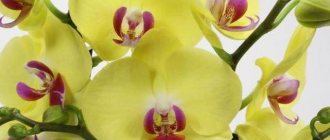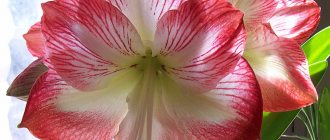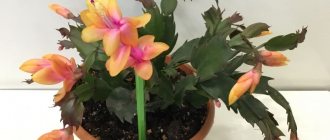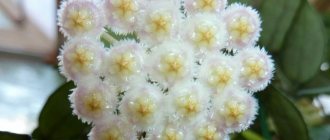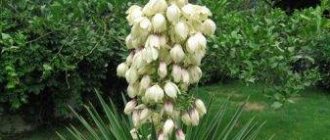The Miltonia orchid comes from warm South American countries with a humid climate, from the orchid family. Includes about 25 different species of orchids, is a perennial herbaceous plant, lives in trees. Outwardly they resemble the Pansy flower.
Many gardeners often have questions about the substrate, choice of pot, watering regime, lighting, relative humidity, temperature conditions at which the plant is kept, feeding and replanting the plant, as well as regarding propagation. The article explains how to properly care for Miltonia orchids.
Features of the plant
It blooms with velvety large flowers, with bright and colorful colors. It has a characteristic pleasant aroma, blooms in summer and autumn, and with good care all year round. Arrows with flowers are not cut off, since they wilt in just a few hours.
Brilliant
He was distinguished by the fact that it was Lindley who at one time found it and wrote it down in his travel notes. It is also called conspicuous - its flowers have a diameter of six to eight centimeters, have crimson or purple longitudinal veins, the main color is soft pink or lavender.
The leaves are lime green, the pseudobulbs are noticeably flattened and appear excessively long. Tolerates both hypothermia and overheating, without reacting to such stress by dropping flowers or withering leaves. Blooms in mid to late summer. It grows as a rather compact and elegant flower, relatively unpretentious and quite elegant.
You can see what the Brilliant Miltonia variety looks like in the photo below:
Brilliant Miltonia
Choosing a substrate for an orchid
The substrate sold in stores is not entirely suitable, so it makes sense to tackle the issue yourself - buy or collect pine bark in the forest, peel and boil it, add charcoal, peat, sphagnum moss, which is added to the mixture in small quantities and placed in the upper part soil. It is strongly recommended to replace moss every three months.
Snow White
It most often blooms in autumn, the flower stalks are more moderate - five to six buds on each. Peduncles of tuberidia grow, the petals on the inflorescences are painted in light colors - always brick speckled, regardless of the shade. The edges of the flowers have a wavy structure; in the middle there is a snow-white lip with a raspberry-pink base.
The flowers are approximately nine centimeters in diameter, quite pretty and very long lasting on the flower. The most elegant and austere of the Miltonias, it will look great in a sophisticated, sophisticated environment, creating the mood to enjoy art.
The photo below shows Miltonia Snow White:
Miltonia Snow White
Choosing a pot
During the transplantation process, a plastic transparent pot is selected in order, firstly, to see the state of the root system, and secondly, the process of photosynthesis is taking place.
Each subsequent pot should be 2 cm larger in diameter than the previous one. Drainage holes are made in the lower part of the pot with a nail or screwdriver.
Yellowish
A very elegant variety; Its natural habitat is in Argentina and has two leaves on each pseudobulb tuberidia. The peduncle is studded with flowers and is capable of bearing from fifteen to a dozen buds at a time. The petals are narrow, straw-colored.
It blooms whenever it pleases - from early March until the last days of August. The flowering process is long and lush, the flower arrow opens from the lower inflorescences while the upper buds are still developing. The delicate creamy color of the petals looks great against the background of the rich greenery of its leaves.
In the photo below is the Miltonia Yellowish variety:
Yellowish Miltonia
The process of watering orchids
Water the orchids either with distillate or with thawed water heated to 30-40 degrees. Do not overdo it with watering, otherwise the root system will rot.
The frequency of watering depends on air humidity and ambient temperature, as well as whether the plant is blooming or not at the moment. Watering is done approximately once every 5 days, and the old water is poured out of the pan and the pot is dried.
Water the orchid by placing it, along with the pot, halfway in a vessel with clean, heated water for 20-25 minutes, and sprinkle the moss on top as well.
Home care
- Stable temperature regime – +18+23°С. Can't stand drafts!
- Doesn't like bright light. There should be diffuse lighting.
- Irrigation using the immersion method. In summer - once every 4-5 days. In winter - half as often, but if the plant is in bloom, then once every 4-5 days.
- Feed twice a month only during active growth with special mineral fertilizers. Reduce the dosage indicated on the package by half. To avoid burns to the plant.
- The first sign that it is time to prune is the wilting of the flowers. It is better to remove the shoots where the flowers were completely, leaving just a couple of millimeters. It is advisable to do this with a special pruner or a sharp knife, but not with scissors!
- Transplantation should be done in the spring, no more than once every two years. After flowering.
- During flowering, do not replant; it is necessary to maintain the temperature regime - at night 3-5 degrees above normal.
- If Miltonia does not bloom, try changing its location. Place it in the eastern or western part of the apartment. And pay attention to whether all other care rules are followed.
Illumination
Orchids do not tolerate direct sunlight; they require indirect light for about 12 hours a day. It is recommended to keep the flower pot in the north-east window in the summer, and in the south in the winter. If there is too much light, the orchid leaves begin to turn yellow, and if there is not enough light, they become dark green, and flowering stops. Depending on the condition of the foliage, the light level is adjusted.
3.Varieties:
3.1.Miltonia Honolulu - Miltonia Honolulu
A compact epiphytic orchid with long, green, glossy, linear leaves up to 25 cm long. The peduncle is strong, vertical, up to 15 cm high. Each flower stem can contain 2 - 3 flowers with a diameter of up to 8 cm, with petals colored violet, lilac or dark pink shades. The lip is wide, with wavy edges. Petals are oblong, often pointed. The flowering period lasts from one and a half to three months.
↑ Up,
Temperature
Elevated temperatures have a very bad effect on the condition of the plant, since under natural conditions it grows in relative coolness. In winter, permissible temperatures are in the range of 12-18 degrees, in summer the maximum is 25 degrees.
The temperature is controlled using a thermometer; if cooling is necessary, the lower part of the pot can be lined with ice cubes.
Honolulu
A hybrid variety, bred by crossing other varieties - the first parent is Miltonia Gayety, and the second plant is Miltonia Anne Warne. Its pseudobulbs have two or three leaves, which are nine centimeters high and about three centimeters wide. Small leaves no larger than fifteen centimeters may stick out from below. Pale purple to purple-red flowers have a distinct darker and sometimes wavy-cut lip. The variety has a delicate and sweetish aroma. It requires moisture, watering and temperature - four to five degrees below street temperature.
Miltonia Honolulu
Air humidity
Recommended air humidity levels are 60-80%, subject to good ventilation of the room. A sign of lack of moisture is curling of the plant leaves.
To ensure normal humidity for the orchid, the air around it is sprinkled with water, but without splashing on the plant itself. Or you can line the pot with wet expanded clay.
Lighting
The indoor plant should be well lit, but slight partial shade is also allowed. It is necessary that there is enough light, but it must be diffused, because direct bright rays can have a detrimental effect on the condition of the flower. Burns may appear on the leaf blades, growth will slow down slightly, which will significantly affect the beauty of the flower bud.
Orchid transplantation
First, remove the flower with the substrate from the old pot, inspect it for the presence of insects, and place it in a solution of cornesil. Dead roots are cut off with previously disinfected scissors.
- Risks of an individual entrepreneur
- Orchid seeds: tips for choosing and rules for growing a flower from seeds. Tips for sowing and growing (120 photos + video)
Orchid pot: how to choose the optimal pot. Features of planting orchids with your own hands (145 photos and videos)
The bottom of the new container is lined with expanded clay or small crushed stone to ensure drainage, a plant with a substrate is placed in the middle, and the pot is immersed in Zircon, a fertilizer that improves the adaptation process. For a better understanding of the process, it is recommended to look at the photo instructions for transplanting the Miltonia orchid.
Characteristic
Miltonia (lat. Miltonia) - belongs to the genus of perennial herbaceous plants of the Orchidaceae family.
In shape and color, Miltonia flowers resemble the wings of an exotic butterfly . The color palette ranges from snow-white to flashy terracotta interspersed with a variety of colors. The diameter of the flower reaches 10-12 cm, the leaves are long and pointed. The edges of the petals may be corrugated.
Miltonia is an epiphyte, meaning it uses branches and tree trunks for support.
Important! Miltonia should not be confused with Miltoniopsis. These are closely related orchids, numbering six species and until recently grouped with the genus Miltonia. But scientific research has proven their genetic differences.
Reproduction
Reproduction of the Miltonia orchid occurs by pseudobulbs and division of the root system. It is best to divide the plant when replanting it. The rhizome is divided in spring, separating part of the tuber along with the shoot from the orchid. The shoot is planted in a mixture of peat, perlite and humus. Watering is carried out 7 days after transplantation.
The pseudobulb is part of the tuber; it is separated after flowering and planted in a narrow container with peat and sand. For escape, a greenhouse is created using a plastic bag, the bag is opened briefly every day, watering is carried out after 4 days, and after the pseudobulb has germinated, the bag is removed.
Bloom
With proper care, Miltonia will be able to bloom all year round with breaks for rest . The flowering of Miltonia does not have a specific time frame, but usually it is about one and a half months. This is followed by a period of rest - about 2 months.
There may be one or two inflorescences per pseudobulb. They are erect and unbranched, often longer than the leaves, and have from 1 to 12 flowers, which can open simultaneously or gradually. When the old 3 or 4 fade, new ones open. At the same time, the plant can produce up to 3 flower stalks.
Diseases and parasites
The cause of diseases is mostly a violation of the temperature regime and insufficient humidity. Damage may occur:
- thrips - the leaves become silver in color, with gray spots on the front side;
- scale insect - the leaves begin to stick and become covered with brown plaques;
- whiteflies - the bottom of the leaf becomes covered with white-yellow spots, becomes discolored, and the plant may die;
- scale insect - the stems and leaf blades begin to dry out sharply.
If the air is too humid and cold, the orchid begins to rot. If signs of disease appear, damaged areas are removed and, if necessary, replanted in fresh soil.
Diseases due to flower pests
Diseases due to flower pests. Unfortunately, miltonia, like most orchids, is susceptible to attack by various insects, which can cause disease and sometimes lead to the death of the flower. Most often, flower growers encounter scale insects, whiteflies and thrips . Each of the pests causes certain harm to the plant, and in this case it is important to notice in time what is wrong with the flower and what insect attacked it:
- Thrips attack the flower when the room temperature is too high and the humidity is very low. These pests lay eggs on the inside of the leaf. After some time, the eggs move to the outside of the leaf. The leaves become silvery-white. You can get rid of this insect only with the help of special poisons (for example, Agravertin or Fitoverm), which can be purchased in specialized stores.
- The scale insect first attacks the Miltonia trunk, and then the leaves. Brown plaques appear on the flower, after which a sticky discharge remains. Special products (“Agravertin” or “Fitoverm”) will also help to defeat this pest.
- The whitefly begins to attack the lower parts of the foliage, leaving behind yellow-white spots. If nothing is done, the leaves will begin to lose their color and then die completely.
If you notice any changes on the flower, immediately begin saving it. The first thing you can do is make a soap solution and wipe the leaves with it. Well, after that you need to use special drugs.
Miltonia is a beautiful and delicate flower that requires attention and care. But caring for this plant is not as difficult and scary as it might seem at first glance, despite the whimsical nature of the orchid. If you create all the necessary conditions for the flower, water it correctly and fertilize it, then its flowering will delight you! We hope this article with photos and tips was useful to you.
What does it look like?
At the base of the orchid there are false bulbs (pseudobulbs) , which reach 8 cm in length and are oval or pear-shaped. They are necessary for moisture reserve.
Above the pseudobulbs rise hard leaves 35-40 cm long, which have a dark green color. From July to October, a long peduncle blooms from the area between the stem and the base of the leaf. It can bear 6 to 8 large flowers. The bud has a round or star-shaped shape, which reaches 10 cm in diameter. The petals have white, terracotta, purple and other colors.
What is the difference from other types?
- The leaves have a different shape - they are longer and narrower, they are not only light green, but also gray-green and sometimes yellowish.
- Flowers always have a contrasting core.
- Miltonias have the most pleasant aroma.
Subsorts with photos
There are about twenty subcultivars of this orchid species . Not counting the hybrid. Here are some of them:
Snow White (Miltonia Candida)
Blooms in autumn. From each bulb 1-2 peduncles up to 40 cm long grow. They form a loose, erect raceme with 3-5 fragrant flowers up to 9 cm in diameter. There are large red-brown spots on the yellow wavy sepals and petals, and a white wavy rounded lip with a purple spot and three short tassels.
Regnelli (Miltonia regnellii)
Regnelli is distinguished by thin glossy leaves and erect peduncles stretching upward . They have from 3 to 7 fragrant flowers with white sepals and petals. The light pink lip has purple stripes and a white border.
Miltoniopsis Phalaenopsis (Miltoniopsis phalaenopsis)
It has short peduncles with 3-5 pure white flattened flowers. The small lateral lobes of the lip are white with light crimson spots and stripes, etc. The white middle lobe is separated by a notch.
Miltoniopsis roezlii
Each peduncle bears from 2 to 5 fragrant white flowers. At the base of the petals there are lilac-lilac spots, and at the base of the lip there is a yellow disc.
Vexillaria (Miltoniopsis vexillaria)
Vexillaria has large flowers, mostly pink with a white border , or with white-pink stripes or spots. There is a yellow spot at the base of the lip. ,
First steps after purchase
In the store, you can and should carefully examine Miltonia so as not to purchase a pest-infested specimen. At home, it’s time for a second, even more thorough check - it is necessary to examine the condition of the roots. Damaged, weakened or dead parts of the root system must be amputated before transplanting into a suitable substrate.
Where the pot will be placed should be determined in advance. Orchids do not like “changing places”; each subsequent movement harms the plant.
Acclimatization of Miltonia takes 7–10 days. At this time, the flower is not watered, but the substrate is only lightly sprayed.
What to do if it turns yellow
The color of the miltonia orchid changes under the influence of diseases or pests and as a result of improper care.
If the plant begins to turn yellow, it is inspected to make sure there are no pests or rot. A healthy specimen has white roots. If they turn brown, it’s time to worry. Then they are cleaned of old soil, washed, and rotten fragments are removed. What is left and the leaves are sprayed with phytosporin. Before planting in the renewed substrate, the orchid is allowed to dry.
If there are pests, treat with an appropriate insecticide.
The transplanted plant is left without watering for 1-1.5 weeks until the wounds on the roots heal. The flower is isolated from the external environment by placing it in an aquarium under glass or creating greenhouse conditions in another accessible way.
The leaves turn yellow and the tips dry out - a signal of inadequate quality of water used for irrigation. It is replaced with rainwater or demineralized water.
Other reasons for yellowing miltonia leaves:
- excessive amount of sun;
- compacted soil;
- soil salinity;
- water entering the petiole sinuses;
- overly concentrated fertilizers that negatively affect the roots;
- low air humidity.
Description
The plant is epiphytic. In nature, it lives on the trunks of mature trees in the bends and depressions of the bark. A distinctive feature is developed aerial roots, located on the surface and supplying the plant with moisture and nutrients. Belongs to the orchid class. The perennial has about 25 species. Each one amazes with its variety of shapes, colors, original patterns on the petals, as well as the extraordinary splendor of large velvety flowers that look like violet pansies and butterfly wings. In addition, its smell is striking - sweet rose with notes of citrus.
Previously, this included specimens living high in the mountains of Brazil. They were then assigned to the genus Miltoniopsis.
Difference from other species
The oblong-pointed long and thin leaves are the main difference between Miltonia and other plants of the orchid family. Its flowers always have a contrasting core and almost always rounded petals.
Our experts have prepared for you reviews of the best varieties of orchids. Read about the bright Cymbidium, capricious Paphiopedilum, charming Sogo, fragrant Vanilla, “revolving” Liodoro, lush flowering Vanda, fragile Big Lip, dark Kaode, luxurious Multiflora and silvery Ludisia.
